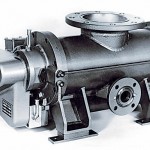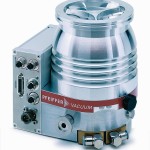With its advertising slogan in Germany, “Nothing Is Impossible,” a well-known Japanese carmaker inadvertently describes the core of vacuum technology. It is presently impossible to use technical means on earth to generate the kind of absolute vacuum that prevails in outer space. However the turbopumps from Pfeiffer Vacuum come pretty close to doing just that. They generate ultra high vacuum of up to 10-11 mbar.
The vast majority of our universe is devoid of all matter, and thus actually consists of absolutely nothing: Barely one atom per cubic centimeter strays into interstellar space. The situation on earth, though, is totally different: Because of our atmosphere, it is still extremely difficult to generate a space-like vacuum today. The quest for ultimate vacuum began at the outset of the past century. One of the pioneers in industrial vacuum generation is Pfeiffer Vacuum Technology AG in Asslar, Germany. Founded in 1890 by Arthur Pfeiffer, the company debuted its first vacuum pump in 1908. By 1926, it numbered among the world market leaders in this field. In 1958, finally, Pfeiffer Vacuum presented the first turbopump. 50 years later, this Asslar-based company is generating more than one-third of its total sales revenues of some 180 million Euro (2006) with these pumps, alone. To mark the 50th birthday of the turbopump, cpp editor Dr. Bernd Rademacher talked about its history, technology and current trends to Armin Conrad, who heads up Research and Development at Pfeiffer Vacuum.
cpp: Mr. Conrad, 50 years after they were first invented, turbopumps continue to be an extremely important pillar of your company. How did this class of pumps come to be developed?
Conrad: Until the development of turbopumps, the industry predominantly utilised oil diffusion pumps to generate vacuum. The disadvantage of these pumps was and is, as the name implies, the oil content in the process. However the 1950s saw more and more applications that required an oil-free vacuum. One stopgap measure was to employ an oil vapor barrier, although this was far from being the best solution. Pfeiffer’s specialist for high-speed shafts, Dr. Willi Becker – an ingen-ious tinkerer –, discovered in connection with his studies that a turbine could produce a pumping effect.
cpp: Could you briefly explain the fundamental principle?
Conrad: When a gas particle strikes a moving wall, it is imparted with an additional component in the direction the wall is moving, in addition to its own thermal speed. If this process is repeated multiple times, the undirected thermal molecular motion is transformed into a directed stream of particles and a pumping process is produced. Pumps that operate in accordance with this principle are therefore called molecular pumps. One problem in connection with this principle of operation consists of collisions between the gas particles, themselves. They counteract the pumping process, which means that a backing pressure of around 10-1 mbar is necessary.
cpp: How did the first molecular pumps look?
Conrad: A turbopump, or turbomolecular pump, essentially comprises a housing with a rotor and a stator. The rotating and stationary discs are alternately arranged, with one rotor disk and one stator disk forming a pump stage. The faster the rotor turns, the greater the pumping effect. Modern pumps operate at rotary speeds of up to 90,000 min-1 and peripheral speeds of 400 m/s. Becker’s self-built prototype did manage to achieve a pumping speed of 142 m/s.
cpp: How have the pumps evolved over the course of time?
Conrad: As I already mentioned, the first pumps operated against a pressure of 10-1 mbar. In order to achieve a higher backing pressure, the so-called Holweck stage was developed in the mid 1990s. It consists of a stationary element containing milled threads and a rotating cylinder. The typical dimensions of a pump channel in this component are a factor of 10 to 50 times smaller than in the turbodisks. Mutual impact between the gas particles therefore does not have any influence until pressures are higher, thus affording standard backing pressures of 10 mbar. Special designs, in fact, enable backing pressures of up to 30 mbar to be achieved.
cpp: What advantages does this mean for the user?
Conrad: There are two major advantages. On the one hand, diaphragm pumps can be used as backing pumps. This results in a completely dry pumping system. On the other hand, the backing pumps can be dimensioned significantly smaller, which naturally results in corresponding cost advantages.
cpp: What trends are being implemented in the current pumps?
Conrad: We naturally continue to strive to improve the technical data of the turbopumps. In recent years, for example, we have been able to significantly increase the reliability of these pumps by means of improved rotor dynamics and sophisticated bearing technology. Pfeiffer Vacuum’s special balancing technology also contributes to this. Further aspects, which are implemented first and foremost in our current series of models, the HiPace turbopumps, include early fault identification, i.e. predictive maintenance, simplified service and lower energy consumption.
cpp: One final question, Mr. Conrad: Where are turbopumps headed?
Conrad: In the future, the task will be to stand up to pressure from the Far East, first of all. This means that the systems will have to be more cost-effective. In this connection, it is always necessary to optimise the major aspects of design, manufacture and delivery. Moreover, users will not be asking for an individual vacuum pump in the future, but for a complete solution that is geared to the application in question.
cpp: Thank you very much for this interview.
„Turbopumps are easy to characterise: The faster the axle turns, the better the pumping effect.“
cpp 402
Turbos are picking up the pace
HiPace is the name of the current turbopumps in the pumping speed range of from 10 to 700 l/s. They offer convincingly high cost-effectiveness and the flexibility that enables all of the pumps in this series to be installed in any desired attitude. Their proven bearing system affords especially high reliability. And their improved rotor design affords higher pumping speeds, higher backing vacuum compatibility and higher gas throughputs, coupled with very good compression of light gases.
Their integrated drive electronics reduce the need for cumbersome and costly cabling. Moreover, a variety of drive versions – including Profibus and DeviceNet – are available without any increase in physical size. The employment of high-strength materials has doubled the service life of the powerful drives. And the runup time of the HiPace, too, has been significantly reduced. This means that the pump is now able to go into service even faster. In addition, the pumps come with expanded remote and sensor functionalities.
In this series, a sealing gas connection safeguards the bearings against particulate matter or oxidizing gases. HiPace pumps are therefore not only compact, they are also highly robust and suitable for industrial applications.
Their functional aluminium housings make these pumps especially light in weight. And the integrated cooling system demonstrates how the performance of turbopumps can be increased even more, without overpacing them.
More about the turbopumps
What is vacuum?
Share:









